– Introduction –
The G6 Lite was released at the pinnacle of slot 2 power by the famous M3 or G6 Team. The carts put out by this team are known for their quality and support. It was everything you could look for in a cart. The price tag on this cart was fairly hefty, almost double that of competitors. However, because of its own excellence, it easily became one of the best slot 2 carts on the market. And even to this day, the G6 Lite is still as strong a competitor today as before.
The G6 Lite was the first cart to be flush fitting on both the DS Lite and the original DS. It is amazing how this was achieved without utilizing the DS’s slot 1. The G6 Lite came in a white shell, however, there are 3 more empty shells that came with it. Using these shells, you can make the G6 Lite sit flush in a variety of DS’s, even matching the color.
– Design –
I bought the G6 Lite off a friend used. Unfortunately for me, the original packaging is missing, and only the tin and its contents were left. All I can say is that the tin looks professional. And that the quality of the tin is quite high. The contents of the tin include 3 cases, the G6 Lite in a white DS Lite shell and a USB reader. The shells fit quite nicely, and they are fairly high quality. The USB reader obviously used a lot. After a lot of banging around, it is still in perfect shape and works perfectly. I can’t possibly ask for higher quality components.
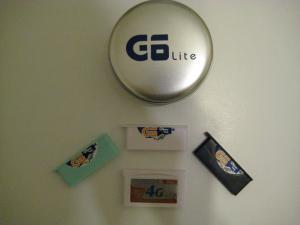
The tin is a nice first impression.
Back to the G6 Lite, the build quality is excellent. In terms of the outer casing, each of the lite sized shells fit in and out of the DS Lite almost as well as the dust cover. I have never slid in and out a lite sized flash cart so sleek. It felt perfect. The cases almost matched the DS Lite’s paint and gloss perfectly, however it is a little off. But other than that, all I can say is that the G6 Lite is rather impressive in terms of build quality.
– Software –
Unlike the many slot 1 carts that feature drag and drop, the G6 Lite goes with the patcher. Which cannot be helped as the G6 Lite came out before the idea of drag and drop. The patcher is relatively easy to use and it patches quite quickly. However, it does have a large array of options that could affect whether the rom works or not.
The patcher is fairly straightforward to use and really quick. One major problem that reoccurs repeatedly is freezes. The G6 program froze a few times during the write process on all three of my computers. But other than that, I have to say, the patching program for the G6 is one of the most elegant and feature-full patchers I have ever seen.
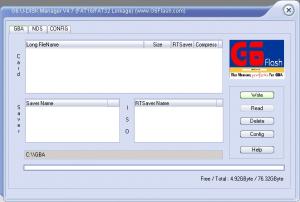
The patcher just looks beautiful!
– Use –
The G6 Lite, after about 3 seconds of load time, features a splash screen that says Touch Pod on the top screen, and displays everything else on the touch screen. I have nothing against that. The G6 Lite’s OS is beautiful, showing 4 games at a time along with their icons in NDS mode. At the top there is a bar showing the current battery level of the G6 Lite, an option to switch to GBA mode, and an little tab that is able to run the G6 Lite’s MoonShell build, another movie/music player and the G6’s other plugins. I can’t really review these plugins simply because they are modified versions of things like moonshell. And also, I had a bit of trouble with them. Seeing some of the forums, it appears most people just delete these plugins to save space.
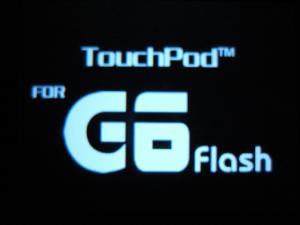
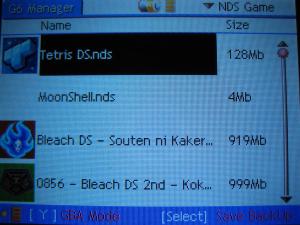
The TouchPod logo seems like a waste of space to me.
When booting a game, the G6 Lite does take a bit of time, about 5 seconds. Fortunately, it has a nice little circle that turns green as the loading is complete. Not a major downside, but it does take longer than most of the newer slot 1 solutions.
The GBA mode of the G6 was disappointing the first time I saw it. It starts of with green writing that says “This product is NOT sponsored, licensed or endorsed by Nintendo”, which was pretty funny the first time I saw it. Then we get the ugly desktop featuring several icons. You cannot select them by moving left and right highlighting an option. Instead, you get a cursor that you have to move with the D-Pad. I don’t know who came up with the idea, but it was one of the most annoying things ever. Anyways, we finally get to the games section, which was beautiful. A fully customizable skin, and little screenshots of games for the icons. However, it still uses the cursor. The load time for the GBA games were almost exactly the same as the NDS mode, slow, but far faster than the Supercard line.
The menu within the GBA game is quite nice, you can save state, you can restart to different menus and you can cheat. The menu is simple and nice, and it gives quite a few versatile options.
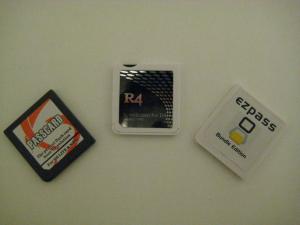
Quick note, you do need a passme, flashme or a passme-capable slot-1 card to run the G6 Lite.
– Functionality –
The G6 Lite ran almost all the NDS roms I threw at it. There were a few odd roms that had to be patched differently, but in the end, it did run everything at full speed. Both Castlevania games ran without a hitch, as well as Tony Hawk’s Downhill Jam. The G6 Lite easily excels in the NDS department. You don’t have to worry about fast MicroSD cards or anything anymore, it has some of the fastest memory built-in.
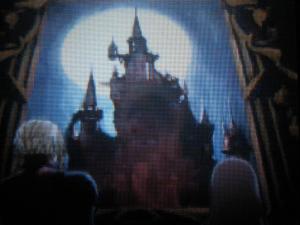
Castlevania: Portrait of Ruin runs flawlessly on the G6 Lite.
On the GBA side, the G6 Lite also performs really well. It also ran everything I tested, I didn’t even need to switch the way I patched it. They all ran full speed. It even has a built-in real-time-clock (RTC) for Pokemon games. However, 1 problem I have faced is the save state. Some GBA games don’t save properly after a save state and gets corrupted. I haven’t had too many of these problems, however, it does get frustrating if you play for a long time, and your save gets corrupted. I guess the best option is still to go with normal in-game saves.
Homebrew is a whole different ball park for the G6 Lite. The G6 Lite has an unofficial DLDI driver and it runs pretty well and patches all the homebrew to work, in general. However, sometimes patching homebrew with DLDI patches get corrupted and so on. But this happens really rarely. All I can say is, if one version of the homebrew doesn’t work, try an older one. The good news is that for major homebrew projects, they usually work, or they have a special build for the G6 Lite. Obviously this includes MoonShell and DSOrganize. To be honest, all of the homebrew I could possibly want worked, it was the obscure homebrew games that I’ve never heard of that didn’t work, and even then it was a hit and miss.
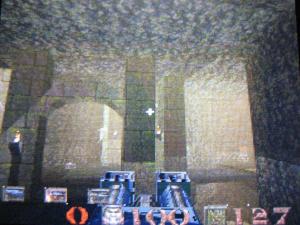
QuakeDS (by Drunkencoders) runs fine on the G6 Lite, however, it cannot save.
– Conclusion –
In conclusion, I can’t believe this cart has been out for almost a year. It runs like a dream, and is still one of the best options you can choose right now. It is certainly a dominating option for users that want a slot 2 cart to pair up with their shiny new R4 flash carts.
If you want NDS, GBA and homebrew applications, and you don’t want to fiddle with all the memory cards, the G6 Lite is the cart you want. Everything runs perfectly. It also looks great. It comes with 4 cases, a GBA sized case, and 3 different colored DS Lite cases. They all fit great, and are easy to change.
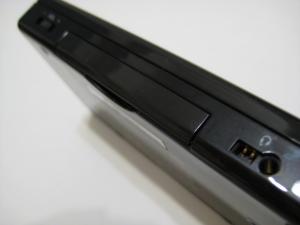
The G6 Lite looks great for all DS and GBA consoles. If you want a flush fitting slot-2 solution, this is the one.
However, there are always some negatives with all carts. The G6 Lite does costs quite a bit of money, it still needs a passme or a flashed DS, and of course, it is limited to 512mb. At 512mb, you can’t store many movies and games. You will have to connect the G6 Lite to your computer a lot.
In conclusion, the G6 Lite is a great cart. It runs everything, but it does have small memory. In my opinion, the G6 Lite is a great starter cart or a second cart to use with a slot 1 cart. However, if you are a DS enthusiast, and you want to try out everything, 512mb is probably not enough memory.
– Score –
Design – 5/5
Software – 5/5
Use – 3.5/5
Functionality – 18/20
Tilt – 4.5/5
Overall – 37/40
